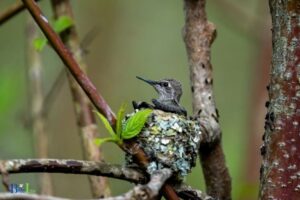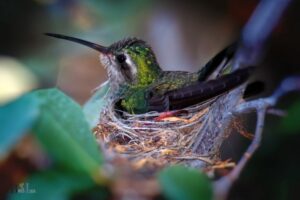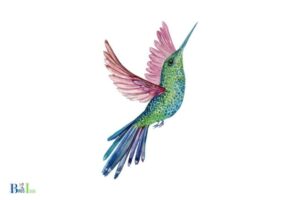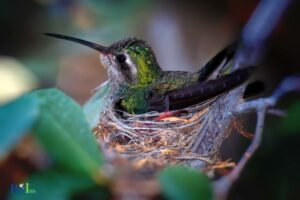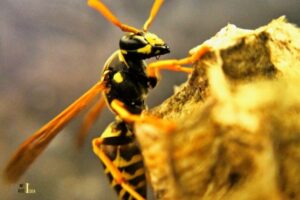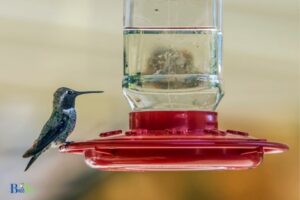How to Hummingbirds Feed Their Babies: A Mixture of Nectar!
Hummingbirds feed their babies by regurgitating a mixture of nectar and insects directly into their mouths.
To provide enough nutrition for their fast-growing chicks, hummingbirds gather nectar from various flowers and catch small insects and spiders.
They then mix this combination in their crop – a pouch-like organ in their throat – and regurgitate the nutrient-rich concoction into the mouths of their hungry babies.
The regurgitated mixture of nectar and insects is essential for the growth and development of hummingbird chicks.
This combination provides the babies with the necessary proteins, fats, and sugars to support their rapid growth.
Within just 18-22 days, the chicks are usually ready to leave the nest and venture out on their own.
The female hummingbird continues to feed her offspring even after they fledge, gradually teaching them how to find food sources before they become fully independent.
4 Stages of Development of Hummingbirds for Their Babies
| Stage of Development | Feeding Frequency | Food Consumed | Method of Feeding |
| Hatchlings | Every 20 minutes | Primarily insect protein and some nectar | Mother regurgitates food into chicks’ mouths |
| Nestlings | Every 30-60 minutes | Insects, spiders, and some nectar | Mother regurgitates food into chicks’ mouths |
| Fledglings | Every 1-2 hours | Increasing nectar, insects, spiders, and pollen | Mother regurgitates food into chicks’ mouths |
| Independent Juveniles | Self-feeding | Nectar, insects, spiders, and pollen | Chicks learn to feed themselves |
Key Takeaway

Five Facts About: How Hummingbirds Feed Their Babies
Understanding The Nutritional Needs Of Baby Hummingbirds
Hummingbirds are fascinating creatures to watch. Their speedy wings and colorful feathers are mesmerizing, and their feeding habits are intriguing. If you’re wondering how hummingbirds feed their babies, you’re in the right place.
Protein-Rich Diets
Baby hummingbirds require a lot of protein in their diet to grow and develop. Adult hummingbirds get their protein from insects, so it’s no surprise that baby hummingbirds require a similar diet.
Some insects that hummingbirds feed their babies include fruit flies, spiders, and gnats.
Here are some key points about protein-rich diets for baby hummingbirds:
- Insects are rich in protein and are crucial for the growth and development of baby hummingbirds.
- Adult hummingbirds catch insects and feed them to their young.
- Baby hummingbirds require a lot of protein, often consuming insects several times per hour.
Flower Nectar And Sugar Water
While protein is crucial for the growth and development of baby hummingbirds, they also require other nutrients to thrive. One of these nutrients is sugar, which is found in flower nectar and sugar water.
Here are some key points about flower nectar and sugar water for baby hummingbirds:
- Flower nectar provides baby hummingbirds with carbohydrates, which they need for energy.
- Adult hummingbirds consume flower nectar and regurgitate it for their young.
- Sugar water can be used as a supplement for flower nectar if it’s not available.
Baby hummingbirds require a diet rich in protein and other nutrients to grow and develop. Adult hummingbirds catch insects and feed them to their young, while also consuming flower nectar and regurgitating it for their babies.
If you’re interested in feeding hummingbirds in your backyard, you can provide them with a sugar water solution in a hummingbird feeder.
By understanding the nutritional needs of baby hummingbirds, you can help these fascinating creatures thrive.
The Role Of The Mother Hummingbird In Baby Feeding
Hummingbirds are fascinating creatures with their unique ability to hover and fly backwards. They also have an interesting way of feeding their babies.
Brooding And Incubating The Eggs
The mother hummingbird’s role in feeding her babies begins before they even hatch.
Here are the key points to note:
- The female bird is responsible for building the nest, where she lays one or two tiny eggs, roughly the size of a coffee bean.
- She then sits on the eggs to keep them warm and incubate them until they hatch, which can take anywhere between 14 to 23 days.
- During this period, she rarely leaves the nest, and the male bird brings her food and also helps protect the nest.
Regurgitating Food For The Chicks
Once the eggs hatch, the mother’s hummingbird’s feeding duties kick into high gear.
Here are some of the essential points to keep in mind:
- Mother hummingbirds are known to feed their chicks a diet that primarily consists of insects, spiders, and nectar.
- Before feeding the chicks, the mother bird must first gather the food by catching insects or lapping nectar from flowers.
- She then regurgitates (brings up) the food to feed her chicks, using her long, thin beak to deposit the food directly into the open-mouthed chicks’ throats.
- This feeding process can occur multiple times per hour, and the mother hummingbird must keep up the feeding until her young can fly away from the nest.
The mother hummingbird plays a critical role in feeding her young, from incubating the eggs to regurgitating food. It’s fascinating to see how these amazing birds have evolved unique strategies to care for their offspring.
The Developmental Stages Of Baby Hummingbirds
Hummingbirds are fascinating creatures, and their unique way of feeding their babies is a wonder to behold.
As a new parent, it is crucial to understand the developmental stages of baby hummingbirds to ensure that they grow and thrive.
Hatching And Nestling
When a female hummingbird lays her eggs, it is an exciting time for the family. Once the eggs hatch, the baby hummingbirds are referred to as nestlings and are entirely dependent on their mother for survival.
Here are some key points to help you understand this stage:
- Baby hummingbirds are blind and featherless when they hatch. They weigh about 1/20th of an ounce.
- The mother hummingbird must keep her nestlings warm and well-fed by regurgitating a mixture of nectar, pollen, and insects.
- The nestlings grow rapidly and will have a full set of feathers within two weeks.
- The mother hummingbird closely guards her nestlings from predators, including squirrels and snakes, and will attack them to protect her young.
Fledgling
The fledgling stage is when baby hummingbirds leave the nest and learn to fly. This stage is crucial as it is when babies acquire the skills necessary for survival.
Here are some key points about the fledgling stage:
- Fledgling hummingbirds usually leave the nest about three weeks after hatching. However, some species remain in the nest for up to six weeks.
- The fledglings may not be the best fliers at first, and it might take them a while to master the skill.
- The mother hummingbird continues to care for her fledglings after they leave the nest, bringing them food and protecting them.
- The fledglings are not entirely independent yet and may return to the nest to rest or be fed by their mother.
The developmental stages of baby hummingbirds are fascinating, and understanding them can help new parents take good care of their young.
Whether it is the initial stages of hatching and nestling or the fledgling stage, mother hummingbirds work tirelessly to ensure that their young are healthy and ready to take on the world.
Learning To Fly And Feed
Hummingbirds are known for their agility and vibrancy, but their behavior during the nesting season is a remarkable sight to observe. From constructing their nests to feeding their young ones, hummingbirds exhibit impeccable parenting skills.
Developing Feeding Techniques
As hummingbirds hatch, they require constant care, support, and nourishment to grow into adult birds. Initially, the hatchlings rely on their mother’s milk for sustenance.
The mother bird feeds them with “pigeon milk,” a fatty, protein-rich fluid produced by the muscle around the bird’s crop.
As the hatchlings mature, they start developing feeding techniques and learn to drink nectar and insects from flowers. Since hummingbirds lack a developed sense of smell, they rely on their eyesight to spot flowers with nectar.
They also associate specific shape and color characteristics with food sources and will revisit similar plants that have provided sufficient nourishment.
Instinct Vs. Learning
While some bird species rely entirely on instinct, hummingbirds need to learn how to feed themselves.
Apart from learning how to identify nectar-producing flowers, they also need to learn how to obtain the nectar, which requires practice.
Young hummingbirds often mistake non-flower-shaped objects for nectar sources, such as red-colored feeders, which may deprive them of essential nutrients.
Hummingbirds learn to extend their long tongues and lap up nectar by mimicking their mother’s actions.
These young birds often make mistakes and require multiple attempts before learning how to balance themselves while feeding.
To summarize, learning to fly and feed are crucial skills that baby hummingbirds develop in their early stages.
They learn to identify nectar-producing flowers, extend their long tongues, and develop the necessary feeding techniques by mimicking their mother’s actions.
Choosing The Right Feeder
Factors To Consider
When choosing the right feeder for hummingbirds, there are several essential factors to keep in mind.
- Size of the feeder: Before selecting a feeder, you should consider the size of the container and the number of birds it can accommodate at once.
- Materials: Hummingbird feeders come in various materials like glass, plastic, and ceramic. Ensure your preferred material is durable and easy to clean.
- Ease of cleaning: The feeder must be easy to clean to prevent the build-up of mold and bacteria that can be harmful to the birds.
- Feeder shape: Hummingbird feeders come in various shapes such as saucer-shaped and bottle-shaped. Choose a feeder that is easy to fill and clean.
- Insect and pest resistance: Choose a feeder that is insect-proof and prevents other pests such as bees and ants from accessing the food.
- Feeder color: Hummingbirds are attracted to bright colors like red, pink, and orange. Choose a feeder with a bright red base to attract hummingbirds quickly.
Ensuring The Feeder Is Clean And Hygienic
Hummingbirds are a delight to watch, with their small size, vibrant colours, and buzzing wings. Watching them feed their babies is even more special.
If you have a hummingbird feeder in your yard, you’ll need to ensure that it is clean and hygienic to keep the little darlings healthy.
Here, we’ll cover the risks of contamination, cleaning techniques, and best practices for cleaning the feeder, ensuring the babies get the best diet possible.
Risks Of Contamination
First and foremost, let’s understand the risks of contamination. Dirty or unclean hummingbird feeders can lead to bacterial and fungal infections, potentially causing disease and even death to the birds.
A contaminated feeder can also attract ants, bees, wasps, and other insects, which can interfere with the feeding process.
To avoid these risks, it’s essential to maintain the feeder’s cleanliness.
Cleaning Techniques And Best Practices
Cleaning the hummingbird feeder is as much an art as it is science. Here are some best practices and techniques for ensuring the feeder remains clean and hygienic.
- Use scalding water to clean the feeder at least once a week.
- Use a solution of white vinegar and hot water to soak the feeder for an hour or more. This technique helps remove mould and fungus.
- Wash all parts of the feeder, including the reservoir, ports, and perches, with a soft brush or sponge.
- Rinse the feeder with clean water, using a non-toxic, gentle soap if necessary.
- Dry the feeder entirely, making sure there is no moisture in any part.
- Store the feeder in a dry, cool place.
- Replace the nectar solution every few days.
- Avoid using harsh chemicals, such as bleach or soap with strong fragrances, while cleaning the feeder.
- Wear protective gloves while cleaning to prevent any contamination due to human hands.
Following these techniques will ensure that the hummingbird feeder stays clean and hygienic, providing the babies with healthy nourishment.
It’s crucial to emphasize the importance of maintaining a clean and hygienic hummingbird feeder to ensure the babies are healthy and thriving.
By regularly cleaning the feeder using the best practices, you can keep the feeder free of harmful bacteria and fungal infections.
FAQ On How To Hummingbirds Feed Their Babies
How Do Hummingbirds Feed Their Babies?
How Often Do Hummingbirds Feed Their Babies?
How Long Do Hummingbirds Feed Their Babies?
What Kind Of Food Do Hummingbirds Feed Their Babies?
How Many Babies Do Hummingbirds Usually Have?
Conclusion
As we conclude, it is fascinating to understand how hummingbirds feed their babies. These birds are unique in their feeding process, and their ability to provide perfect nutrients for their offspring is worth admiring.
The provision of nectar and insects by the female hummingbirds at an early stage, and the gradual process of self-feeding and learning by the young ones, is a remarkable event in nature.
The parental role and the scientific significance of the feeding process cannot be overlooked. The understanding of how hummingbirds feed their babies creates awareness, admiration, and curiosity about these tiny birds.
Through their tenacious and amazing display, these birds remain a vital part of our ecosystem.
Overall, hummingbirds are a fascinating bird that contributes to the beauty and importance of nature.

